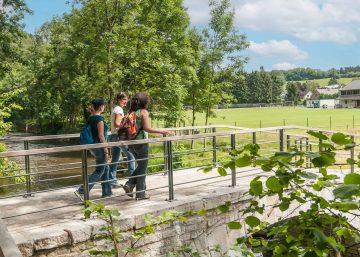The Oût’leûs
These navigators of the Ourthe, aware of the dangers of the job, usually had three men to steer the boat.
When the boat was lowered, two men manoeuvred it: the driver (often the master boatman), who operated the heavy rudder at the stern, and the second man, who straightened the bow of the pontoon using the gaff (a large wooden handle). He had to be able to use his arms to increase or decrease the amplitude of the movements initiated by the rudder and to give precision to the movements of the pontoon when passing through the river.
A third man, the dj’volî (rider) worked mainly on the way up to pull the boat: he accompanied the draught horse on the towpaths, either sitting astride his horse, facing the river to anticipate any dangers, or accompanying it on foot. On the way down, the horse would take its place in the boat.
Die Oût’leûs
Diese Ourthe-Fahrer, die sich der Gefahr ihres Berufs bewusst waren, waren in der Regel zu dritt, um das Boot zu steuern.
Bei der Talfahrt bedienten zwei Männer das Boot: Der Bootsführer (oft der Bootsmeister) bediente hinten das schwere Ruder und der zweite Mann richtete den Bug des Pontons mit dem Gaffel (einem großen Holzstiel) auf. Er musste in der Lage sein, die vom Ruder eingeleiteten Bewegungen mit der Kraft seiner Arme zu verstärken oder zu bremsen und den Bewegungen des Pontons beim Durchfahren der Flusspassagen Präzision zu verleihen.
Ein dritter Mann, der dj’volî (Reiter), arbeitete vor allem beim Aufziehen, um das Boot zu ziehen: Er begleitete das Zugpferd auf den Treidelpfaden, indem er entweder im Amazonas auf seinem Pferd saß und sich dem Fluss zuwandte, um mögliche Gefahren vorauszusehen, oder indem er das Pferd zu Fuß begleitete. Bei der Abfahrt nahm das Pferd seinen Platz im Boot ein.
